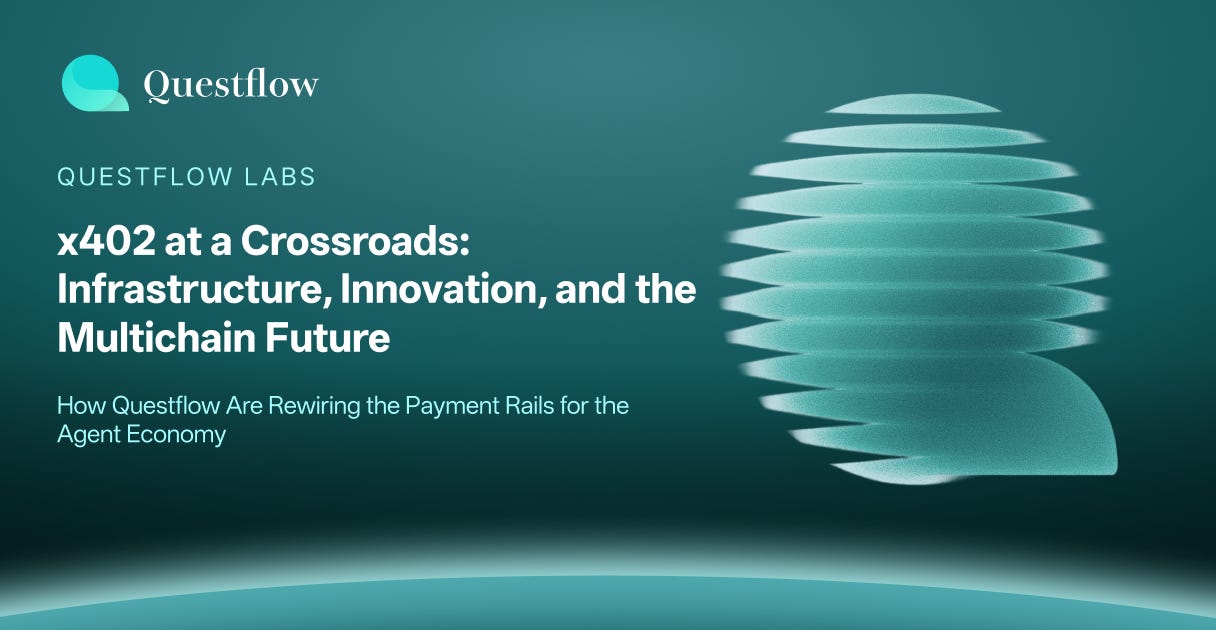x402 at a Crossroads: Infrastructure, Innovation, and the Multichain Future
How Questflow Are Rewiring the Payment Rails for the Agent Economy
The Rise of x402 and Its Open Payment Vision
In the decentralized AI and Web3 automation boom, one of the most ambitious ideas to emerge is agent-to-agent (A2A) commerce—where digital agents not only automate tasks but transact with each other in real time. Powering that future requires something Web2 payments can’t deliver: an open, interoperable, and gasless way for software agents to make payments without backend infrastructure.
Enter x402, a new standard inspired by HTTP 402—”Payment Required”—designed to enable instant crypto-native payments directly over HTTP. Pioneered by OpenAI’s Plugin protocol and now finding ground in crypto-native settings, x402 decouples billing from blockchain infrastructure, allowing payments to flow through lightweight endpoints called facilitators.
With the launch of x402scan.com and several thousand transactions being routed daily through leading facilitator nodes like Coinbase and Questflow, the protocol is reaching critical mass. But success brings scrutiny. And as usage grows, so do infrastructure bottlenecks, developer friction, and a strong need for ecosystem resilience.
We try to offers a ground-up look at the state of x402—what works, what doesn’t, and what’s being built to fix it. We also highlight how Questflow leading the effort to strengthen x402’s multichain backbone.
The Current State of x402 — Growth, Adoption, and Its Structural Design
A Lightweight Protocol, Heavyweight Potential
x402 is not a blockchain protocol itself—it’s a metered billing layer. Any API, agent, or app that exposes a URL can declare a price in crypto (via an HTTP header) and rely on a registered facilitator to verify, process, and forward payment metadata.
It’s elegant and extensible. But its apparent simplicity hides deep assumptions:
It assumes a reliable, always-online facilitator.
It assumes ERC-20 token standards (often relying on ERC-3009) are present and usable.
It assumes the sender is on the right chain with sufficient gas and tokens.
These assumptions begin to crack at scale.
What’s Missing from x402 Today — Infrastructure Gaps and Developer Concerns
1. Single Chain Dependency
The original x402 flow assumes both sender and facilitator operate on a specific chain (often Base). But this means any app on Arbitrum, Polygon, Optimism, or other chains is out of luck unless it builds a facilitator from scratch.
This lack of multichain support makes x402 less accessible than it should be—and fragments adoption.
2. Fragile Facilitator Dependency
Today, if Coinbase’s facilitator fails or becomes rate-limited, users can’t pay. There’s no native fallback, redundancy, or load-balancing.
This creates an unwanted centralization risk in an otherwise open protocol.
3. ERC-3009 Limitations
x402 payments often rely on ERC-3009, a standard for delegated transfer authorization. But not all tokens support this natively, especially newer ones, and its gas behavior is inconsistent across chains.
This results in failed transactions, poor UX, and difficulty integrating custom tokens.
4. Developer Onboarding Pain
While x402 is technically simple, getting started still requires understanding facilitator registries, writing correct headers, managing token approvals, and dealing with edge cases like cross-chain interactions.
The result? High friction for Web2 and Web3 developers alike.
5. Visibility and Trust
Because x402 payments happen off-chain and then land on-chain, they’re harder to audit in real time. For non-crypto-native developers or enterprises, this invisibility becomes a compliance and trust issue.
What the Community Is Saying
Across X (Twitter), developers and builders have expressed:
Requests for plug-and-play multichain facilitators
Concerns over single point of failure in facilitator setups
Frustration with ERC-3009 compatibility
Interest in building fallback routes using other facilitators like PayAI or Questflow
The Ecosystem Response — How to Build the Missing Layers
Questflow’s Multichain Facilitator
Questflow launched the first public Multichain Facilitator, solving a key friction point. It allows any developer to:
Accept x402 payments on multiple EVM chains (e.g. Base, Optimism, Arbitrum)
Route tokens using supported wallets and fallback logic
Simplify approval via unified interface
This turns x402 from a single-chain dependency into a cross-chain opportunity, dramatically improving its developer friendliness and resilience.
Fixing ERC-3009 Pain
Questflow also introduced workarounds and token mapping for ERC-3009 compatibility:
Token abstraction layer to detect and route based on token type
Integration fallback using permit-based approvals
This opens the door for broader token adoption, especially for projects with custom smart contract tokens.
Other Ecosystem Contributors
While Questflow lead infrastructure development, others are contributing:
PayAI — deploying alternative facilitator nodes
Agentic Labs — exploring analytics and dashboard tools for x402 tracing
OpenAPI contributors — working on standardizing error reporting and metadata for x402 endpoints
Building with x402 Today — How to Join the Ecosystem via Questflow’s Facilitator
If you’re a developer or agent builder interested in supporting x402 payments, you can start today using Questflow’s multichain facilitator.
✅ Go to:
https://facilitator.questflow.ai
Here’s what you can do:
Apply as a facilitator user to access APIs and endpoint config
Register your token, set gas caps, and enable testnet support
Deploy your own agent, app, or workflow using x402 headers
Monitor transactions via the dashboard and fallback logs
Questflow’s portal comes with default configurations and wallet simulations to reduce onboarding time.
Toward a More Resilient and Decentralized A2A Economy
The vision behind x402 is bold: enabling a global marketplace of autonomous agents who can buy and sell services instantly, trustlessly, and cheaply. But visions require infrastructure—and today’s x402 ecosystem, while promising, is still maturing.
From multichain support to facilitator reliability, we’re seeing both the pain points and the community responses come into focus. Questflow’s Multichain Facilitator mark major steps forward, giving x402 the architectural scaffolding it needs to scale.
For developers, now is the moment to experiment—and for ecosystem contributors, the time to build. Because the next internet won’t just be smart. It’ll be self-paying.
To start building with x402, check out
https://facilitator.questflow.ai.


